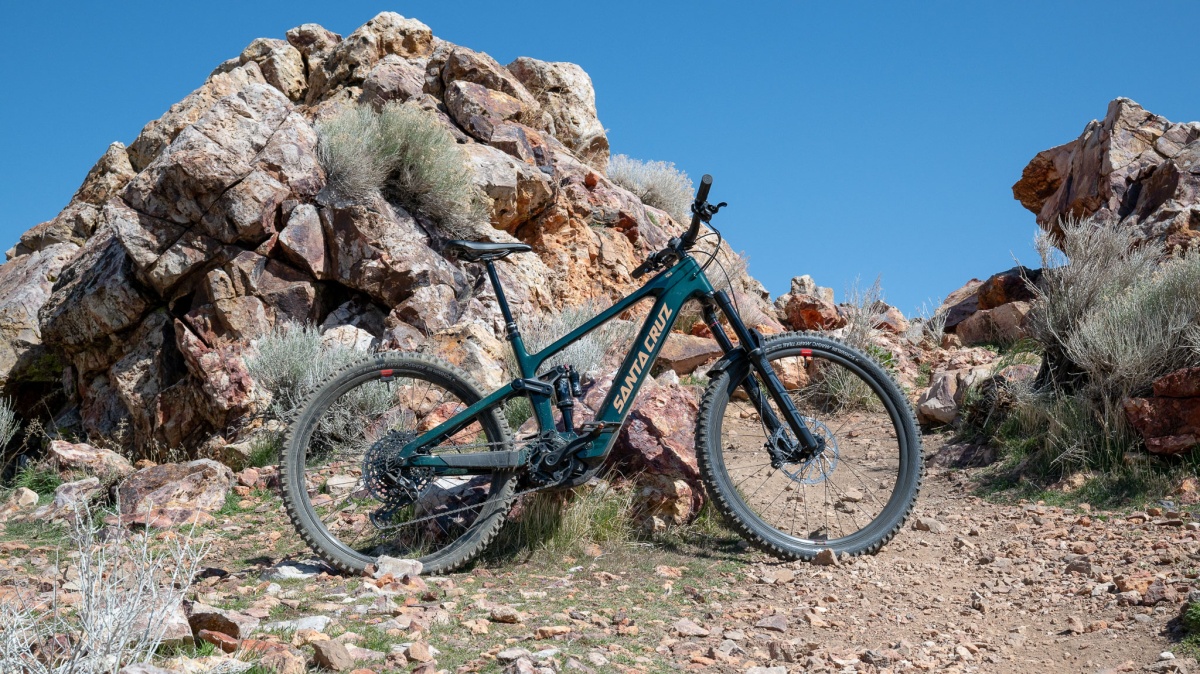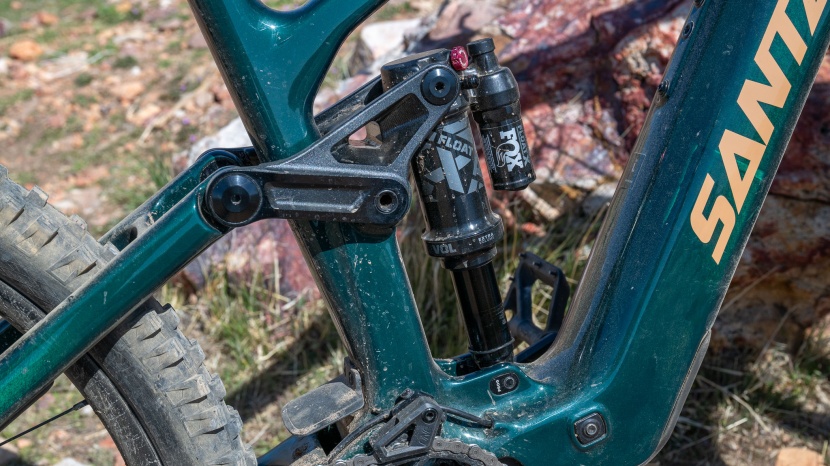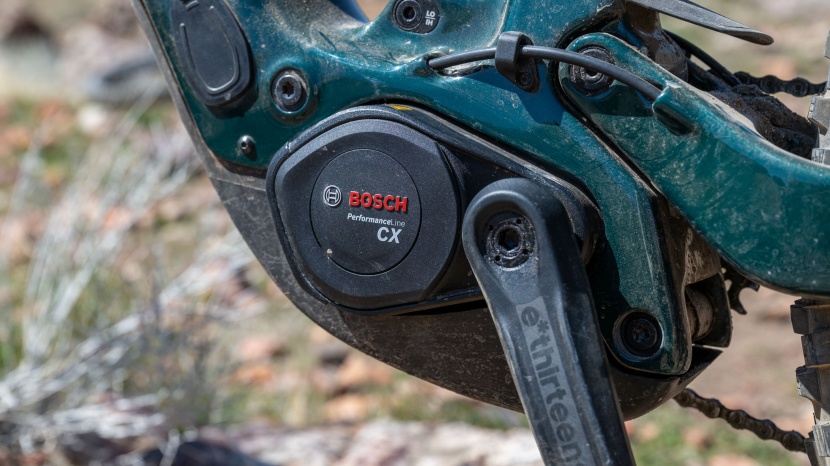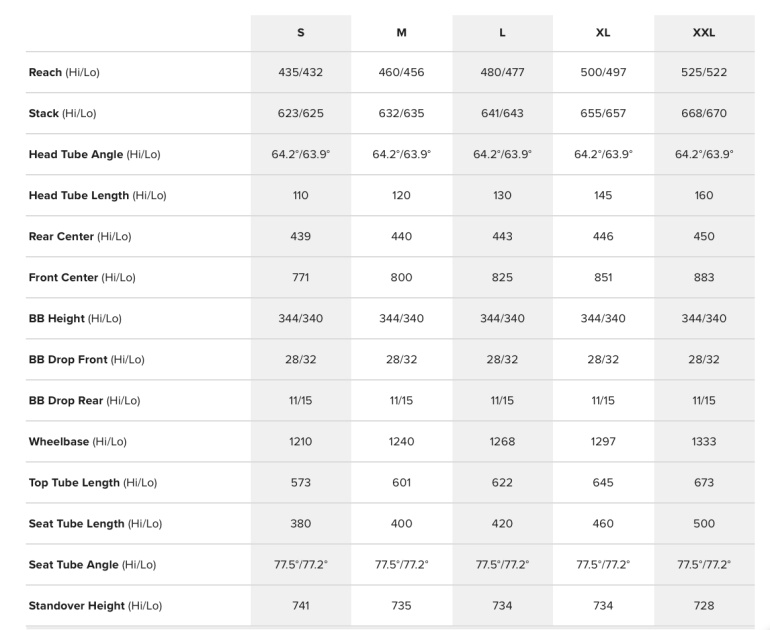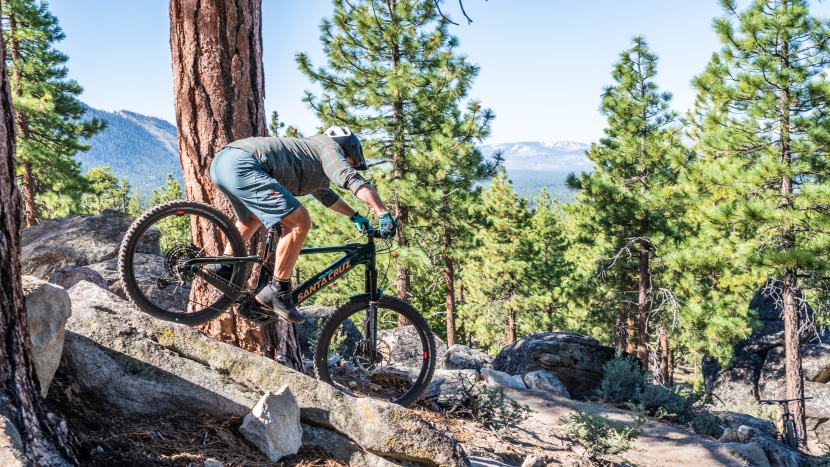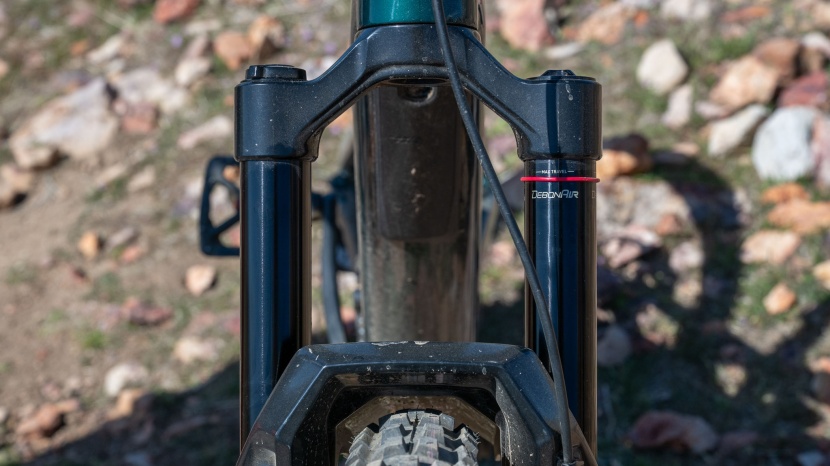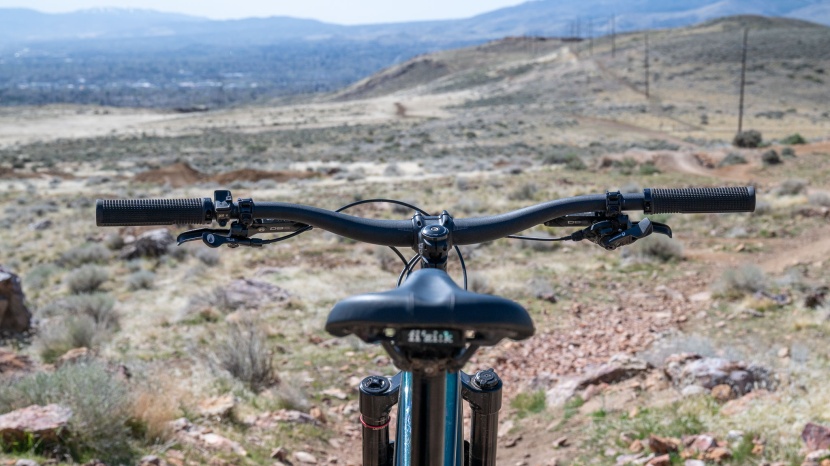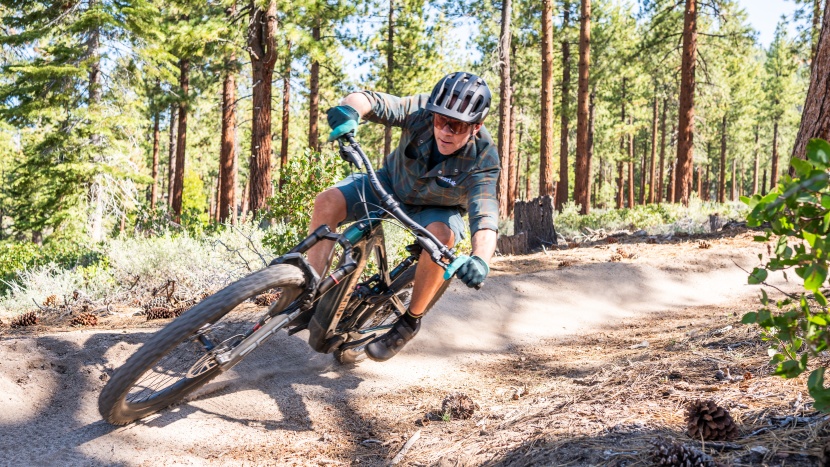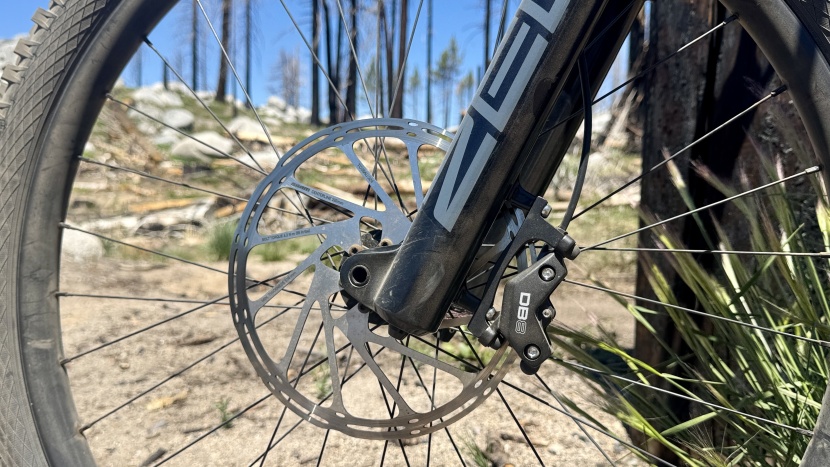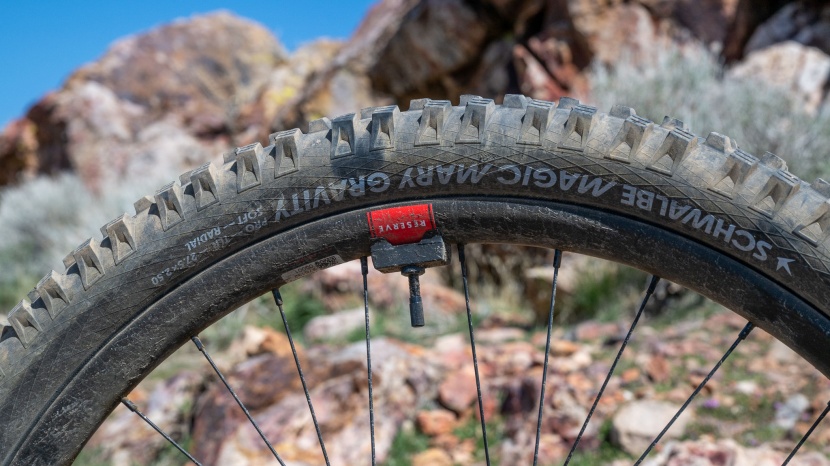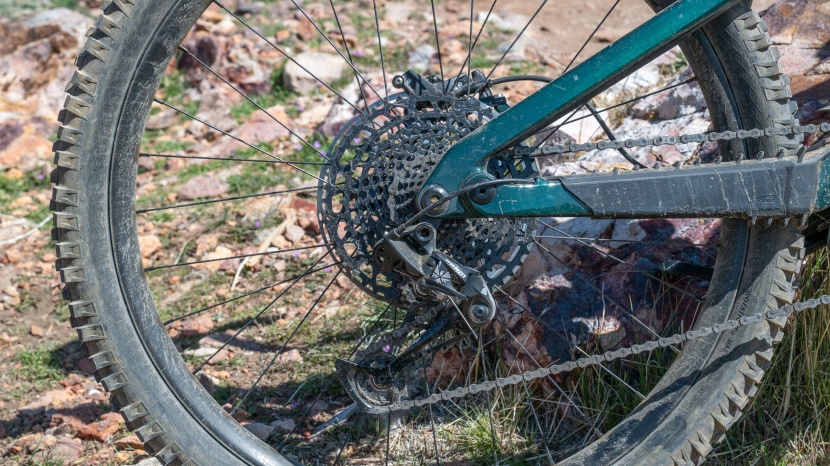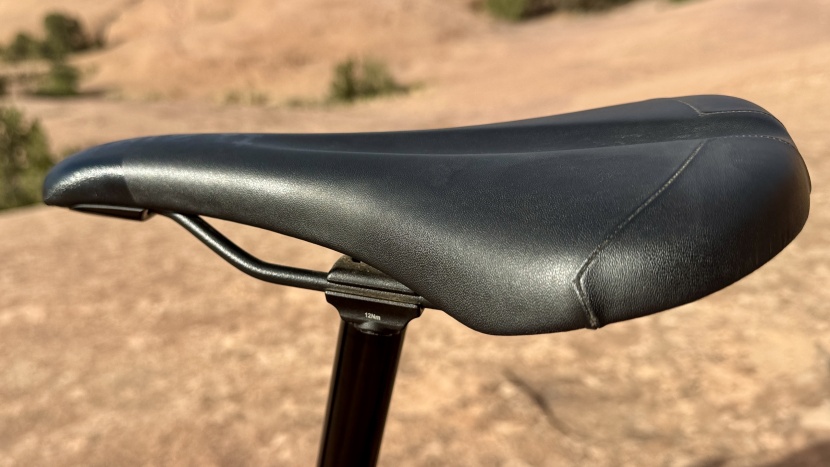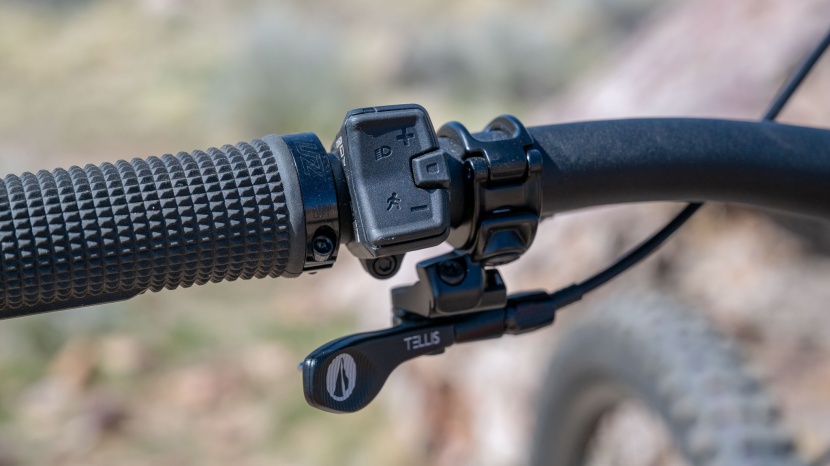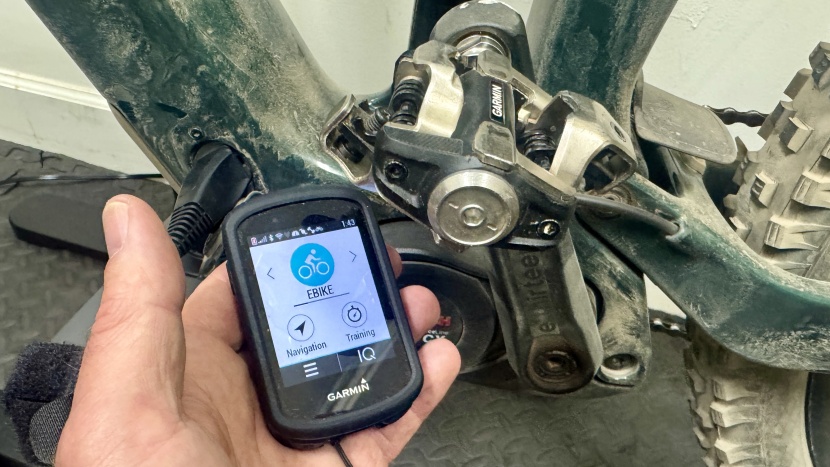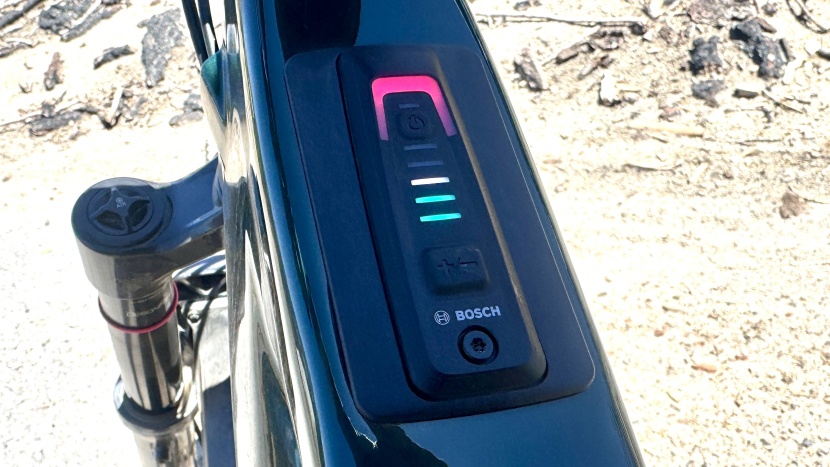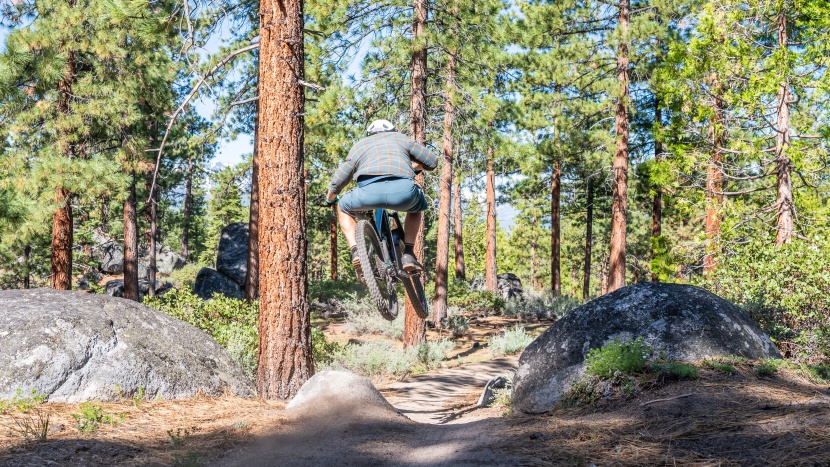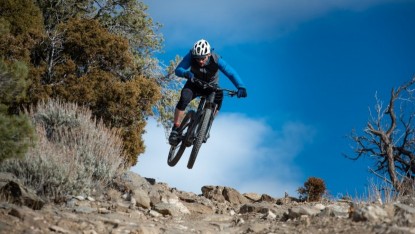
Our Verdict
Our Analysis and Test Results
Santa Cruz had to deviate from the VPP to achieve the desired kinematics for a full-powered mullet e-bike. Like the new Bullit, the Vala uses a 4-bar linkage with a low center of gravity and packs a Bosch CX motor with a 600Wh battery. Bosch offers manufacturers a choice between a 600Wh and 800Wh battery, and the Vala is not compatible with the latter. However, it can utilize Santa Cruz's modular Powermore range extender, which packs an additional 250Wh of juice.
Design Highlights
- All carbon frames in C or CC layup
- Bosch Performance CX motor
- Independently adjustable geometry and shock rate
- 150mm of 4-bar travel (160mm fork)
- 600Wh battery and 250Wh range extender available
- MX platform, 29" front - 27.5" rear wheel
- Coil shock compatible
- 5 frame sizes S-XXL
Frame Design
The Santa Cruz Vala was designed around the motor and battery, not the VPP layout for which Santa Cruz is known. The downtube houses a smaller (and lighter) battery mounted down low to give the bike a lower center of gravity and handling that isn't dominated by the bike's mass. The C carbon frame features a geo flip chip that allows you to adjust the geometry and a progression flip chip that enables you to fine-tune the progression from 26-29%, which will make the rear end feel more or less reluctant at the top of its travel. The geo flip chip lowers the bottom bracket by 4mm and slackens the head tube angle by .3 degrees. The frame has in-molded cable routing tunnels, a Bosch display in the top tube, and mounts for a water bottle or range extender on the downtube. The 4-bar rear end gives up 150mm of travel and pairs with a 160mm fork. The frame uses a 205mm shock with 60mm of stroke, mounted vertically in front of the seat tube, which keeps it clean and easy to access. Unlike Santa Cruz VPP bikes, you don't feel like you're resting your teeth on the handlebars to adjust your rear shock.
The frame has low-slung, clean lines but a congested-looking motor / bottom bracket area. The smooth tubes and slick-looking machined linkages give way to a busy juncture of motor, pivots, charge port, flip chip, and briefly exposed cables. It's certainly a feat of engineering and fitment, and somewhat surprising that it all fits together. The Vala utilizes a one-piece bridge link to prevent sideloads, along with Santa Cruz's trusted bearings and seals, which carry a lifetime warranty.
The bike is designed for aggressive trail riding, and Santa Cruz doesn't hold back with the geometry. All sizes share head tube angles of 64.2°/63.9 ° and seat tube angles of 77.5°/77.2 ° in their respective Hi/Lo settings. Our large test bike has a reach of 480/477mm, and all sizes have unique rear center lengths, with ours measuring 443mm. Santa Cruz achieved size-specific chainstay lengths by moving the pivot rearward on larger bikes, but all sizes use the same rear end. In the high setting, the BB sits at 344mm and drops to 340 mm in the low setting, which is low enough to give the bike a playful, carving nature.
Downhill Performance
The Vala slaps! Slipping through tree lines, blasting corners, airing out the big hits, and crushing hard lines, the bike never feels like less than enough. The suspension remains remarkably composed, and the Schwalbe Radial tires provide it with absolutely heroic traction. The confidence-inspiring ride pushes you to find creative lines and go harder than you might on almost any other bike. The long (1268mm) wheelbase gives the bike so much stability, but somehow feels playful and fun at the same time. The ride quality is somewhat reminiscent of the Bronson, which makes sense given their similarities. Importantly, the Vala doesn't lose sight of the fun and flickable nature of Santa Cruz's mullets, but it doesn't have that deep stroke compliance that the VPP has become renowned for. The Vala still gets deep into its travel, it's just a bit more reluctant to get there. In the progressive setting, the shock curve turns upward, making that deep stroke feels even more elusive.
The bike catapults out of berms and high-speed corners with a spry and lively feel. Its lower mass and lower center of mass give it an advantage in playful terrain, where you can seek out smoother lines through the air and make the most of side hits. When the trail flows, the Vala's cockpit is a great place to be, you can lean deep into corners, manual the rhythm sections, and preserve your momentum like you're on an analog trail bike. I wasn't excited about the Vala's smaller battery, but the more time I spent on the bike, the more I appreciated the lighter weight and lower center of gravity. You can always add a range extender for longer days in the saddle.
I tested the Vala alongside two other full-power bikes (Levo Gen4 and Ibis Oso), and the differences between them are stark. On paper, the Vala is the loser; it has a smaller battery, a higher price, and decidedly wimpy parts spec. But.. numbers on paper don't give us the whole story, which is why I have a job pedaling these bikes around and parsing out the differences. The Vala is one of the funnest, full-powered trail bikes I've ridden in recent memory. Before testing this bike, I might have told you that the difference between 50 pounds and 52 pounds is negligible, but the slightly lighter bike feels significantly more agile as you whip downhill, especially when that weight it's lower in your downtube.
The CX line motor produces 85Nm of torque, which is on the lower end of the average for 2025. There is enough power to get a quick jump on acceleration between the big hits or have a peppy sprint. The motor doesn't feel particularly refined or quiet, with an audible “whrrrr” that pushes you forward. There is a distinct feeling when the motor powers on and off; it doesn't subtly blend into the background like you feel with some other power trains. Some of what I term a lack of refinement can be cleaned up with adjustments in the app, I cover that below.
The head tube houses a 160mm RockShox Zeb that inspires confidence and doesn't complain about where you land it. While it's the base model fork, I had no complaints about the valving or damping of the front end. A similar story applies to the Fox Float X on the rear; there aren't many adjustments, and I didn't miss them. Sometimes I feel like e-bikes can get away with simplified suspension since pedaling efficiency is an afterthought, and you're saving some dough. Much of the bike, however, has a paltry build that doesn't lend itself to high-intensity losses in elevation. Sram DB8 brakes use 220mm rotors instead of Mavens and 200mm rotors; they do a decent job of slowing your roll, but we're accustomed to seeing these brakes on bikes priced under $3,000. Similarly, the NX drivetrain feels like a paper plate holding a fancy meal.
The geometry is an evolved modern mullet set up with angles that let you test physics and ride like you're trying to punish the tires. Speaking of tires, the Schwalbe Magic Mary radials have over-the-top grip. You can read my entire review of these tires, or simply know that they provide better traction than anything else on the market, allowing you to achieve higher speeds and deeper angles than you might think possible. The cockpit is fairly basic, featuring an E13 base handlebar and a RaceFace Chester stem. The bar measures 800mm with a 35mm rise (Size small has a 760mm bar with a 20mm rise), and the stem extends the bars 40mm forward of the steerer. An SDG Telis dropper provides 200mm of drop and does a fine job of keeping the saddle out of the way on rowdy descents. The small size comes with a 125mm dropper, while the medium gets 170mm of drop. Our test bike had a Fizik saddle instead of the SDG Bel-Air V3 that is on the spec sheet, but it didn't cause any complaints.
Climbing Performance
An e-bike's climbing performance is dictated by more factors than just the motor's power. Of course, some robust assistance helps push you up those inclines. Most of our testers agreed that ripping up steep trails on the Vala was at least as fun as descending. The bike's geometry, namely the steep seat tube angle and tight chainstays, lends it to spirited climbing. Your weight stays in front of the rear axle on all but the steepest pitches, which balances your weight distribution between the wheels and gives you exceptional traction. This also prevents the front end from becoming unweighted and wandering about.
Combining the geometry advantage with the tire's intense grip and the motor's oomph, you find yourself scurrying up climbs you may not have thought were possible. The bike is long but not so long that you can't finesse tight switchbacks or lift the front end for additional agility. Your forefingers stay on the brakes; the exhilaration of your speed is compounded by the technical challenges you're conquering. For those without much experience on a full-power ebike, it's remarkable how much of our perceived technical riding actually comes down to power. You still need to have some bike handling skills and good timing, but the bike's power and mass give you a distinct advantage as you parse out technical ascents.
Your heart rate isn't pinned, but here you are, climbing steep, rocky trails with a smile on your face and enough composure left to scout for side hits and find some creative lines. The motor has abundant power, but it doesn't exactly feel polished. The power comes on with a more abrupt feeling than you get on a Levo (Gen 3 or 4). This can be adjusted, but it never feels as well-integrated as some of the other e-bike motors. Some of my favorite climbs aren't sustained inclines but rolling ascents that have fast sections, technical challenges, and tight, low-speed maneuvers. These climbs require a fair bit of input to the shifter and a lot of variation in cadence and power. The Bosch motor in these sections feels more binary in its output, cycling on and off; it doesn't provide the smooth, buffered assistance that I feel from some of the other powertrains on the market.
Build
The build on Santa Cruz's least expensive Vala is decidedly lackluster. When we purchased this bike (and yes, we purchase all of the bikes we test), there was no SRAM 70 build option; that Transmission mechanical offering came later. I won't spend too much time bashing the build, but it doesn't feel appropriate on a bike at this price point. The SRAM NX drivetrain uses a PG-1230 cassette, which threads to an HG freehub body. This means you can't upgrade your cassette without also purchasing a new freehub body. The HG freehub body sits on a SRAM 746 hub, which has a lackluster engagement speed and weighs almost 800 grams. The slow engagement can mask the motor's quick reaction time and creates a clunky expereience in technical ratcheting situations. The brakes and drivetrain are the same as those we tested on the Aventon Ramblas which sells for 1/3 the price of the Vala R. All of these parts work fine but distract somewhat from how rad the bike is. I rode this bike with several diffrent wheelsets that made vast improvements to the bikes performance.
Photo Tour
The Vala comes with a base-level suspension package, including a Rock Shox Zeb and Float X Performance rear shock. The Zeb, even as a base model, is fantastic, and its chassis is perfectly suited for e-bike service. Its crown stiffness is in line with that of the Fox 38, and I found it to be supple, quiet, and responsive. While I might advocate for upgrading the handlebars, brakes, and drivetrain, a better solution would be to purchase the model above this one.
Power Output
The Bosch CX Performance motor cranks out 85Nm of torque with a whirring buzz from the bottom bracket. The motor's noise feels more noticeable than other models, but I never found it annoying or overly pronounced. 85Nm used to be the high water mark, but Specialized recently dropped their 3.1 motor with 101Nm of torque (111Nm of S-Works models), while DJI's Avinox M1 motor puts out 105- 120Nm of torque. More power and torque don't necessarily make for a better experience, but it's worth noting where the Vala sits in comparison to its competition.
I spent a few rides tuning the motor's parameters through the Bosch Flow app; by lowering the assistance and increasing the dynamic I was able to find a setting that coplimented my style of riding. If your trail appetite is larger than the battery, pedaling the bike without power is doable, but not incredibly enjoyable. Riding without the bike's ample assist helps you understand just how much the motor changes the bike's ride quality and dynamics. While there are several motors with more power, they consume more energy, resulting in less range or increased weight. I'm not sure if this is the perfect balance of power and weight, but this bike is exceptionally agile feeling, and I never felt like I needed more power.
Range
With the 600Wh battery fully charged, I set out on our test course, which features a relatively steep paved and gravel climb, followed by a single-track return.
I was able to ride 22.6 miles and climb 3750 feet of elevation on the Vala. This doesn't mean that's as far as you can ride, but instead provides a baseline for a worst-case scenario where your legs are barely working and you're relying on the bike's full power. The Flow app provides a range estimate for the 600Wh battery with 27 miles for Turbo, 36 miles for eMTB, 52 miles in Tour+, and 67 miles in Eco. Given the amount of vert I rode with such little input wattage in our test course, the Bosch estimates seem totally reasonable. Adding a 250 Wh PowerMore range extender could likely increase your range by almost 40%. I appreciate that Santa Cruz didn't use Bosch's optional 800Wh pack in this bike and instead gave users the option to ride the lighter bike and add the range extender when needed.
E-bike Controls
Your pedal assist modes are controlled through a wireless remote that sits next to your dropper lever on the left grip. The two-button remote (there are 3, but the Select button is only used for error codes) has a simple plus / minus interface and worked flawlessly during my test period. The Bosch top tube display is rudimentary, featuring a power button at the top and redundant +/- buttons on the bottom; this is important should you lose connection with the wireless remote. The display features 5 bars to indicate the battery's charge and a color-changing LED at the top that signifies your pedal-assist mode. There are four ride modes: Green (Eco), Blue (Tour+), Purple (eMTB), and Red (Turbo). Using the app, you can customize the ride modes and their behavior, but the bike has a maximum of four settings. Notably, there is an Auto setting that enables the bike to adjust its torque and assist levels according to your torque input and riding style.
Powering the bike up requires just a simple push of the button on the top tube, and the display lights up, showing the current ride mode and state of charge. You can switch between ride modes using either the lower button on the display or the wireless remote, the latter being more convenient while riding. A long push of the - button activates walk mode but Bosch has another interesting feature with this button. If you put your foot on the pedal and then push and hold the - button, the motor enters “Hill Start Assist” mode, which helps you get moving. A long push of the + button can activate a headlight, but there is no lighting wired into the Vala. The charge port sits on the non-drive side of the downtube just in front of the bottom bracket. A soft rubber cover opens toward the back of the bike to guard the battery from ingress. The position works for adding a range extender, but we were constantly cleaning dirt and dust from the port as it sits in the line of fire from the front end.
Using the Bosch Flow App, which is free to download, you can make a wide array of adjustments and customizations to the way the motor behaves. You can adjust the maximum speed, 20 mph or less, and the maximum torque, 85Nm or less, for each ride mode. You can also adjust assistance to increase or decrease the support level of each mode. Less assistance means you'll receive a lower level of support based on your power input. This tones down the motor's power, allowing you to get a more intense workout. The inverse is true with raising the level of support. The motor dynamic can also be adjusted; this changes how quickly the motor's power ramps up and provides acceleration; turning this all the way up results in a wild bronco feeling that is harder to control.
Should You Buy the Santa Cruz Vala?
The new Vala has some bright spots in its performance, and it's one of the funnest e-mtb's I've been on. It is not, however, a great value when compared to other bikes in this category. Sure, Santa Cruz bikes carry a premium price tag, but this bike feels like it's priced for the consumer who doesn't care about the price and wants what the brand is offering. If you're not hung up on the price or in need of a more dedicated range, the Vala will most certainly put a smile on your face. If I were to recommend a particular build, the 90 build stands out as a good compromise of performance and value, but it's still really expensive for what you get, and you don't get the sweet Schwalbe radials on that model. There are many great bikes on the market right now, and when you compare numbers, the Vala doesn't seem very competitive. Looking past the numbers, the Vala offers a more fun, lively, and aggressive ride quality, which may result in a difference of pennies per mile. So, accept my value critique with a grain of salt and climb aboard one.
What Other Electric Mountain Bike Should You Consider?
Not a lot of inexpensive, high-end electric, carbon mountain bikes on the market these days, but price is relative. If you're happy with the performance of the Bosch CX line motor, I'd recommend taking a closer look at the Ibis Oso, which features a better fork, drivetrain, cockpit, larger battery, and built-in headlight, all for almost $1000 less. If you want the best motor dynamics, the Gen4 Levo is the pinnacle of integration, offering a smooth and quiet power band with tremendous tunability. The entry-level carbon model is priced a bit higher but has a much nicer spec, larger battery, and more power. The other bike I'd point to is the YT Decoy. It's available with several different builds that are all compelling and value-priced. The Decoy has similar geometry, mullet wheels, and a very similar suspension layout.


